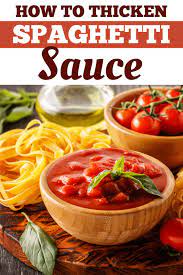Easy and Delicious Ways How to Thicken Spaghetti Sauce
Are you tired of dealing with watery and runny spaghetti sauce? Don’t worry, we have got you covered! In this article, we will share some easy tips and tricks to help you thicken your spaghetti sauce, giving it a rich and velvety texture that will leave your taste buds craving for more.
1. Simmer Slowly: One of the most effective ways to thicken your spaghetti sauce is to simmer it slowly. By cooking the sauce on low heat for a longer period of time, you allow the excess moisture to evaporate, resulting in a thicker consistency. Consider simmering your sauce for at least 30 minutes to an hour, stirring occasionally to prevent sticking.
2. Add Tomato Paste: If you want to add an instant boost of flavor and thickness to your spaghetti sauce, tomato paste is your secret weapon. Tomato paste is concentrated and has a thick consistency, making it perfect for thickening sauces. Simply stir in a tablespoon or two of tomato paste into your sauce and let it cook for a few minutes to incorporate the flavors.
3. Incorporate Cornstarch or Flour: Another popular method to thicken spaghetti sauce is by using cornstarch or flour. Mix a tablespoon of cornstarch or flour with an equal amount of cold water to make a slurry. Gradually add the slurry to your sauce while stirring constantly. Cook the sauce for a few minutes until it reaches the desired thickness.
4. Blend in Cooked Vegetables: If you prefer a more natural and healthy way to thicken your spaghetti sauce, consider blending in cooked vegetables. Vegetables like carrots, onions, and bell peppers have a natural thickening effect due to their high fiber content. After cooking the vegetables, puree them in a blender and add them to your sauce for an added richness.
With these simple tips, you can easily transform your runny spaghetti sauce into a thick and luscious delight. Experiment with these techniques and find the one that works best for you. Get ready to enjoy a hearty plate of spaghetti with a sauce that clings perfectly to every strand!
How to Make Spaghetti Sauce Thicker: 6 Easy Tips
Whether you prefer a thick and hearty spaghetti sauce or want to salvage a watery batch, there are several easy tips to help you achieve the desired consistency. Here are six methods to thicken your spaghetti sauce:
| Tip | Description |
|---|---|
| 1 | Simmer for Longer |
| 2 | Add a Roux |
| 3 | Use Tomato Paste |
| 4 | Incorporate Bread Crumbs |
| 5 | Stir in Mashed Potatoes |
| 6 | Blend in Cornstarch Slurry |
Simmering your spaghetti sauce for a longer duration can help reduce excess liquid, resulting in a thicker sauce. Remember to stir occasionally to prevent sticking and burning.
Adding a roux, which is equal parts fat and flour cooked together, can thicken your sauce and add a rich flavor. Simply melt the fat in a saucepan, whisk in the flour until smooth, and cook for a few minutes before adding it to your sauce.
Tomato paste is another fantastic thickening agent since it is concentrated and packed with flavor. Stir in a tablespoon or two of tomato paste and let it cook for a few minutes to incorporate into the sauce.
If you’re in a bind, bread crumbs can come to the rescue. They absorb excess liquid and add texture to your sauce. Simply sprinkle a handful of breadcrumbs into the sauce and let them simmer for a few minutes until the desired thickness is achieved.
Mashed potatoes might seem like an unconventional choice, but they can be an excellent thickening agent for spaghetti sauce. Mix in a small amount of mashed potatoes and let them cook into the sauce, adding a creamy texture and extra thickness.
Another option is to create a cornstarch slurry by dissolving cornstarch in water and then slowly adding it to your simmering sauce. This mixture will thicken the sauce quickly. Just remember to stir continuously to ensure even distribution and prevent lumps.
By utilizing these six easy tips, you can thicken your spaghetti sauce to perfection and enjoy a deliciously rich and hearty pasta dish.
Adding Tomato Paste
Tomato paste is a great way to thicken spaghetti sauce while adding a rich and concentrated tomato flavor. Here are some tips on how to add tomato paste to your sauce:
- Start by adding a small amount of tomato paste, about 1-2 tablespoons, to your sauce. You can always add more later if needed.
- Use a whisk or spoon to gradually stir the tomato paste into the sauce, making sure to break up any clumps.
- After adding the tomato paste, let the sauce simmer for a few minutes to allow the flavors to meld together.
- If you find that your sauce is still too thin, you can add more tomato paste, a little at a time, until you achieve the desired consistency.
- Remember that tomato paste can be quite potent, so be cautious not to add too much, as it can overpower the other flavors in your sauce.
Tomato paste is a versatile ingredient that adds depth and thickness to any spaghetti sauce. Experiment with different amounts to find the perfect balance for your taste buds.
Simmering for a Longer Time
One easy way to thicken spaghetti sauce is to simmer it for a longer period of time. Simmering allows the flavors to meld together and the sauce to reduce, resulting in a thicker consistency.
To simmer your sauce for a longer time, start by bringing it to a boil. Once it reaches a rolling boil, reduce the heat to low and let it simmer uncovered. This will allow the excess liquid to evaporate and thicken the sauce.
It’s important to stir the sauce occasionally to prevent it from sticking to the bottom of the pan and burning. You can also use a lid partially placed on the pot to minimize splattering, but make sure to leave enough room for steam to escape.
The longer you simmer the sauce, the thicker it will become. Keep in mind that the sauce will continue to thicken as it cools, so don’t worry if it seems a little thin while still hot. If you prefer a very thick sauce, you can simmer it for up to several hours.
| Tips for simmering for a longer time: |
|---|
| 1. Use a wide and shallow pot to increase the surface area and promote faster evaporation. |
| 2. Adjust the heat as needed to maintain a gentle simmer. |
| 3. Taste the sauce occasionally and adjust the seasonings as desired. |
| 4. If the sauce becomes too thick, you can add a little water or broth to thin it out. |
By simmering your spaghetti sauce for a longer time, you can achieve a thicker, more flavorful sauce that will cling to your pasta perfectly. Give it a try and enjoy!
Using Cornstarch as a Thickener
If you’re looking for a simple and effective way to thicken your spaghetti sauce, cornstarch can be a great option. Cornstarch is a common thickening agent that is used in many recipes, and it can easily be added to your sauce to give it a thicker and more luxurious consistency.
How to Use Cornstarch to Thicken Spaghetti Sauce
Using cornstarch to thicken your spaghetti sauce is a quick and easy process. Here is a step-by-step guide on how to do it:
- Start by preparing a slurry. Mix 1 tablespoon of cornstarch with 2 tablespoons of cold water in a small bowl. Stir until the cornstarch is completely dissolved.
- Next, add the slurry to your spaghetti sauce. Make sure the sauce is hot and simmering before adding the cornstarch mixture. Slowly pour the slurry into the sauce while stirring continuously.
- Continue stirring the sauce for a few minutes to ensure that the cornstarch is evenly distributed and fully incorporated. As the sauce heats up, the cornstarch will activate and thicken the sauce.
- If the spaghetti sauce is still not thick enough to your liking, you can repeat the process with another slurry of cornstarch and water.
Benefits of Using Cornstarch
There are several benefits to using cornstarch as a thickener for your spaghetti sauce. Firstly, cornstarch is a neutral-tasting thickener, so it won’t alter the flavor of your sauce. This is particularly important if you’ve spent time carefully developing the taste of your sauce with a blend of herbs and spices.
In addition, cornstarch is a gluten-free thickener, making it a suitable option for those with dietary restrictions or gluten sensitivities. It’s also a versatile ingredient that can be used in a variety of recipes beyond spaghetti sauce, so it’s a great pantry staple to have on hand.
Using cornstarch to thicken your spaghetti sauce is an easy and effective method that can help you achieve the desired consistency. Give it a try and enjoy a delicious, thickened sauce that will take your spaghetti dishes to the next level!
Incorporating Cooked Vegetables
Adding cooked vegetables to your spaghetti sauce not only adds flavor and texture, but can also help to thicken the sauce. Here are a few vegetables that work well:
- Onions: Sauteed onions can add a rich, savory flavor to your sauce. Simply dice the onions and cook them in a bit of olive oil until they are soft and translucent.
- Carrots: Carrots can add a touch of sweetness and help to thicken the sauce. Finely chop or grate the carrots and cook them until they are tender.
- Celery: Celery adds a subtle, refreshing flavor and can also help to thicken the sauce. Chop the celery and cook it until it softens.
Once your vegetables are cooked, you can add them to your spaghetti sauce. Simply stir them in and let them simmer for a few minutes to allow their flavors to meld with the sauce.
If you prefer a smoother sauce, you can blend the cooked vegetables in a blender or food processor before adding them to the sauce.
By incorporating cooked vegetables, you not only enhance the taste and texture of your spaghetti sauce, but also give it a nutritional boost. Plus, it’s a great way to use up any leftover veggies you may have on hand!
Adding a Roux to the Sauce
If you’re looking to thicken your spaghetti sauce, one easy method is to add a roux. A roux is a combination of equal parts fat and flour, used as a thickening agent in cooking. It’s commonly used in Italian cuisine to add body and richness to sauces.
To make a roux, melt butter or heat olive oil in a saucepan over medium heat. Once the fat is melted, gradually whisk in an equal amount of all-purpose flour. Continue whisking until the mixture is smooth and has a paste-like consistency.
Next, you’ll need to cook the roux. This step is important because it helps remove any raw taste from the flour. Cook the roux for a few minutes, stirring constantly, until it turns a light golden color. Be careful not to let it burn.
Once the roux is cooked, you can gradually add it to your spaghetti sauce. Start by adding a small amount at a time, mixing well after each addition. As the roux combines with the sauce, it will help thicken it and give it a creamier texture.
Remember, the amount of roux you’ll need will depend on how thick you want your sauce to be. If you prefer a thicker sauce, you can add more roux. Just be sure to adjust the seasonings accordingly, as the roux may dilute the flavors of the sauce slightly.
Adding a roux to your spaghetti sauce is a simple and effective way to give it a thicker consistency. By following these easy steps, you’ll be able to enjoy a more satisfying and hearty sauce that is sure to impress your dinner guests.
Pureeing Some of the Sauce
Another easy way to thicken spaghetti sauce is by pureeing some of it. This method works well if you prefer a smoother texture and want to thicken the sauce without adding any additional ingredients.
To puree the sauce, you can use a blender, food processor, or immersion blender. Simply transfer a portion of the sauce into the blender or food processor and blend until smooth. If you’re using an immersion blender, you can blend the sauce directly in the pot.
Once the sauce is pureed, you can add it back into the pot with the rest of the sauce and stir to combine. The pureed sauce will help to thicken the overall consistency and add a velvety smoothness.
Keep in mind that pureeing some of the sauce may change the flavor slightly, as the pureed portion will distribute throughout the sauce. If you want to maintain the original flavor, you can reserve some of the sauce before pureeing and add it back in if needed.
This method is particularly practical if you have a chunky sauce with large pieces of vegetables or meat that you want to break down.
If the sauce is still not thick enough after pureeing, you can repeat the process with more sauce until you achieve the desired consistency.
Overall, pureeing some of the sauce is an easy and effective way to thicken spaghetti sauce without adding any extra ingredients. It allows you to create a smoother texture while maintaining the flavor of the sauce.
“FAQ:” How to thicken spaghetti sauce
How can you enhance the consistency of a tomato-based sauce, and what are the best ways to thicken it?
The consistency of a tomato-based sauce can be improved by using ingredients like tomato paste, grated cheese, or incorporating starchy elements such as flour or cornstarch.
In the context of pasta sauce, what role does heavy cream play, and how does it contribute to the overall texture and flavor?
Heavy cream adds richness and creaminess to pasta sauce, creating a velvety texture and enhancing the overall flavor with its buttery notes.
When aiming to thicken a tomato-based sauce containing ground beef, what techniques can be employed, and how do they impact the sauce’s composition?
To thicken a tomato-based sauce with ground beef, you can opt for browning the meat or using a roux (a mixture of flour and fat). These methods contribute thickness and flavor complexity to the sauce.
How does the addition of starchy elements affect the texture of tomato-based sauces, and what alternatives can be considered for those seeking gluten-free options?
Starchy elements like flour or cornstarch contribute thickness to tomato-based sauces. For gluten-free alternatives, you can use arrowroot, potato starch, or gluten-free flour.
In what culinary context is the term “gravy” typically used, and how does it differ from traditional tomato-based pasta sauces?
The term “gravy” is often used in the context of meat-based sauces, especially those made with pan drippings. It differs from traditional tomato-based pasta sauces, which are centered around tomatoes and can include various ingredients like herbs, spices, and meats.
How can you learn how to thicken your homemade spaghetti sauce, and what are some simple ways to achieve this?
To learn how to thicken homemade spaghetti sauce, you can use techniques such as reducing, adding starchy ingredients, or incorporating pasta water.
What role does pasta water play in thickening a sauce, and how can it be utilized effectively in the cooking process?
Pasta water, rich in starch, can be used to thicken a sauce by adding it gradually during cooking. This starchy water helps enhance the sauce’s consistency.
When trying to thicken a watery spaghetti sauce, what practical steps can you take to reach your desired consistency?
To thicken a watery spaghetti sauce, you can simmer it, add starchy ingredients like flour or cornstarch, or blend it with a food processor for a smoother texture.
How does adding cream cheese contribute to thickening spaghetti sauce, and why is it considered one of the best ways to achieve a creamy texture?
Adding cream cheese to spaghetti sauce not only thickens it but also imparts a rich, creamy texture and enhances the overall flavor, making it one of the best methods.
In what way can butter and flour be combined to thicken a sauce, and what is the process involved in using this technique?
Combining butter and flour creates a roux, which is then added to the sauce to thicken it. This process involves cooking the flour in melted butter until it forms a smooth paste.
How can cornstarch be utilized to thicken spaghetti sauce, and what benefits does it offer in terms of achieving the desired thickness?
Cornstarch can be added to spaghetti sauce as a thickening agent. It’s beneficial for achieving the desired thickness and creating a smooth, glossy texture.
What role does allowing the sauce to boil play in the thickening process, and how does it impact the overall consistency of the sauce?
Allowing the sauce to boil helps evaporate excess moisture, concentrating flavors, and thickening the sauce. It contributes to achieving the desired consistency.
When dealing with a watery spaghetti sauce, how can adding heavy cream be effective in thickening it, and what considerations should be kept in mind?
Adding heavy cream to a watery spaghetti sauce provides richness and helps thicken the sauce. It should be added gradually, adjusting the thickness according to preference.
What techniques are often used to thicken meat sauce, and how do they contribute to enhancing both texture and flavor?
Techniques such as reducing, incorporating starchy ingredients, or using tomato paste are often employed to thicken meat sauce, contributing to improved texture and flavor.
In the process of thickening a sauce, why is it recommended to leave it uncovered, and how does this practice influence the thickening outcome?
Leaving the sauce uncovered during cooking allows moisture to evaporate, aiding in the thickening process and resulting in a more concentrated and flavorful sauce.






